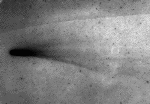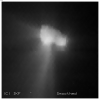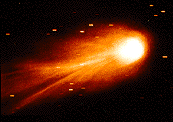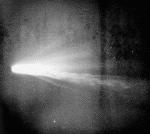 |
 |
In 1705 Edmond Halley predicted, using Newton's newly formulated laws of motion, that the comet seen in 1531, 1607, and 1682 would return in 1758 (which was, alas, after his death). The comet did indeed return as predicted and was later named in his honor.
The average period of Halley's orbit is 76 years
 but you cannot calculate the dates of its reappearances
by simply subtracting multiples of 76 years from 1986. The gravitational
pull of the major planets alters the orbital period from revolution to
revolution. Nongravitational effects (such as the reaction from gasses
boiled off during its passage near the Sun)
also play an important, but smaller,
role in altering the orbit. Between the years
239 BC and 1986 AD the orbital period
(measured at the closest 40-day epoch to each
perihelion passage)
has varied
from 76.0 years (in 1986) to 79.3 years (in 451 and 1066).
(The closest
perihelion passage to the time of Jesus are 11 BC
and 66. Neither event took place in Jesus's lifetime.)
but you cannot calculate the dates of its reappearances
by simply subtracting multiples of 76 years from 1986. The gravitational
pull of the major planets alters the orbital period from revolution to
revolution. Nongravitational effects (such as the reaction from gasses
boiled off during its passage near the Sun)
also play an important, but smaller,
role in altering the orbit. Between the years
239 BC and 1986 AD the orbital period
(measured at the closest 40-day epoch to each
perihelion passage)
has varied
from 76.0 years (in 1986) to 79.3 years (in 451 and 1066).
(The closest
perihelion passage to the time of Jesus are 11 BC
and 66. Neither event took place in Jesus's lifetime.)
Halley's orbit is retrograde and inclined 18 degrees to the ecliptic. And, like all comets, highly eccentric.
Only three comets have been visited by spacecraft. NASA's ICE passed through
 the tail of Comet Giacobini-Zinner in 1985; Comet Grigg Skjellerup
was visited by Giotto in 1989. In 1986, five spacecraft from
the USSR,
Japan, and the European Community visited Comet Halley;
ESA's Giotto
obtained close-up photos of Halley's nucleus (above and right).
the tail of Comet Giacobini-Zinner in 1985; Comet Grigg Skjellerup
was visited by Giotto in 1989. In 1986, five spacecraft from
the USSR,
Japan, and the European Community visited Comet Halley;
ESA's Giotto
obtained close-up photos of Halley's nucleus (above and right).
The nucleus of Comet Halley is approximately 16x8x8 kilometers.
Contrary to prior expectations, Halley's nucleus is very dark: its albedo is only about 0.03 making it darker than coal and one of the darkest objects in the solar system.
 The density of Halley's nucleus is very low: about 0.1 gm/cm3 indicating
that it is probably porous, perhaps because it is largely dust remaining after
the ices have sublimed away.
The density of Halley's nucleus is very low: about 0.1 gm/cm3 indicating
that it is probably porous, perhaps because it is largely dust remaining after
the ices have sublimed away.
Halley is almost unique among comets in that it is both large and active and has a well defined, regular orbit. This made it a relatively easy target for Giotto et al. but may not be representative of comets in general.
Comet Halley will return to the inner solar
system in the year 2061.
